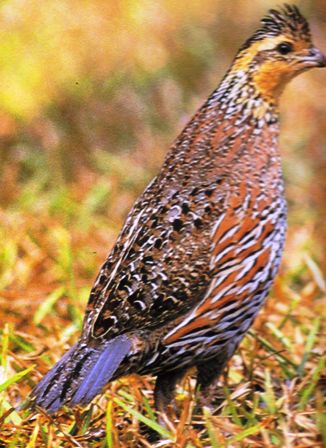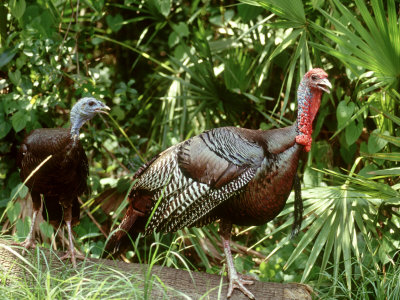Discover Florida Nature
It's time to explore the natural Florida


|
|
|
|
|
 Northern
Bobwhite- The bobwhite is Florida's only quail. The Northern
bobwhite, sometimes called bobwhite quail, is one of the signature
species of upland
long leaf pine forests. Visitors to these habitats can expect to
hear the males make the tell tale whistled call – bobwhite – and it’s
not uncommon to be surprised by a sudden explosion of birds as a covey
of quail flushes from a brushy area. The Northern bobwhite is a
medium-sized, round-bodied bird with a short tail and neck. Plumage is
reddish brown with streaking on the sides. Males have a black-and-white
face pattern; in females it is black-and-buff. The most obvious feature
of the bobwhite are the small head and plump body. Bobwhites feed and
roost in flocks (coveys) of 8 to 25 birds. When families of bobwhites
roost for the night, they cluster in a circle facing outward with their
bodies touching. This wagon-train formation helps conserve warmth and
allows a watch for predators in all directions. Bobwhites hunt on the
ground in search of fruits, seeds, insects and plant parts. Females lay
12-16 eggs in a shallow nest built on the ground and hidden beneath
vegetation Northern
Bobwhite- The bobwhite is Florida's only quail. The Northern
bobwhite, sometimes called bobwhite quail, is one of the signature
species of upland
long leaf pine forests. Visitors to these habitats can expect to
hear the males make the tell tale whistled call – bobwhite – and it’s
not uncommon to be surprised by a sudden explosion of birds as a covey
of quail flushes from a brushy area. The Northern bobwhite is a
medium-sized, round-bodied bird with a short tail and neck. Plumage is
reddish brown with streaking on the sides. Males have a black-and-white
face pattern; in females it is black-and-buff. The most obvious feature
of the bobwhite are the small head and plump body. Bobwhites feed and
roost in flocks (coveys) of 8 to 25 birds. When families of bobwhites
roost for the night, they cluster in a circle facing outward with their
bodies touching. This wagon-train formation helps conserve warmth and
allows a watch for predators in all directions. Bobwhites hunt on the
ground in search of fruits, seeds, insects and plant parts. Females lay
12-16 eggs in a shallow nest built on the ground and hidden beneath
vegetationNorthern bobwhites occur throughout Florida in appropriate habitat. In addition to mature upland forests, the best habitats include fallow agricultural fields dominated by such species as ragweed, and the edges of cultivated grain fields. The best combination is probably a combination of agriculture, without excessive weed control, interspersed throughout regularly burned mature pine forest. At one time, this was a very common habitat in Florida and abundant quail populations were a by-product of an extensive land use pattern in Florida. This is not the case today and quail occur in abundant numbers only on those lands which are intensively managed to replicate the land use patterns described above.  Wild
Turkey- The Florida wild turkey (Meleagris gallopavo osceola),
also referred to as the Osceola, is found only on the peninsula of
Florida. It's similar to the eastern wild turkey, but is smaller and
darker in color with less white veining in the wing quills. The white
bars in these feathers are narrow, irregular, broken and do not extend
all the way to the feather shaft. The black bars predominate the
feather. Secondary wing feathers are also dark. When the wings are
folded on the back, there are no whitish triangular patches as seen on
the eastern. Feathers of the Florida turkey show more iridescent green
and red colors, with less bronze than the eastern. The dark color of the
tail coverts and the large tail feathers tipped in brown are similar to
the eastern, but unlike the lighter colors of the three western
subspecies. Its colorations and behavior are ideal for the flat pine
woods, oak and palmetto hammocks and swamp habitats of Florida. Adult
females, or hens, are similar to the males but duller and lighter
colored throughout, except wing feathers, which are darker. The male
turkey has a large tail which it can spread in a fan shaped display like
a peacock. Female turkeys are called "hens", young males "jakes" and
mature males "gobblers". Wild
Turkey- The Florida wild turkey (Meleagris gallopavo osceola),
also referred to as the Osceola, is found only on the peninsula of
Florida. It's similar to the eastern wild turkey, but is smaller and
darker in color with less white veining in the wing quills. The white
bars in these feathers are narrow, irregular, broken and do not extend
all the way to the feather shaft. The black bars predominate the
feather. Secondary wing feathers are also dark. When the wings are
folded on the back, there are no whitish triangular patches as seen on
the eastern. Feathers of the Florida turkey show more iridescent green
and red colors, with less bronze than the eastern. The dark color of the
tail coverts and the large tail feathers tipped in brown are similar to
the eastern, but unlike the lighter colors of the three western
subspecies. Its colorations and behavior are ideal for the flat pine
woods, oak and palmetto hammocks and swamp habitats of Florida. Adult
females, or hens, are similar to the males but duller and lighter
colored throughout, except wing feathers, which are darker. The male
turkey has a large tail which it can spread in a fan shaped display like
a peacock. Female turkeys are called "hens", young males "jakes" and
mature males "gobblers".Wild turkey hens in Florida typically begin laying in late March or early April. Clutches average 10.3 eggs and take approximately 12-13 days to lay. Eggs hatch after 25-26 days of continuous incubation. Poults will roost on the ground for the first 14 days after hatching. During this period, approximately 70 percent mortality occurs, primarily through predation. Only 45-50 percent of wild turkey nests successfully hatch. Most are lost to predators, although occasionally nests are lost by other means (agricultural activities, flooding, etc.). However, hens often renest if their initial nest is destroyed. Major wild turkey nest predators include raccoons, striped and spotted skunks. Other nest predators include opossums, gray foxes, coyotes and domestic dogs. Predators are a natural element in a wild turkey's environment and attempts to control predators are usually ineffective and economically unfeasible. Efforts are better spent developing and maintaining good quality brood habitat which is often the limiting factor on wild turkey populations. Good brood habitat has 1-3 foot vegetation (grasses, weeds, etc.) open enough to provide unimpeded movement for young poults, yet dense enough to provide cover from predators. Good brood habitat also provides seeds, insects, and succulent growth for poults to feed upon. |
|
|
Advertise | Privacy Statement | Dog Encyclopedia | Video |Contact | Alaska Nature |
|